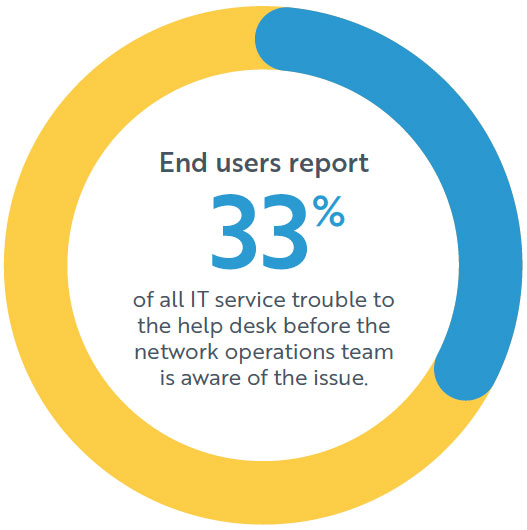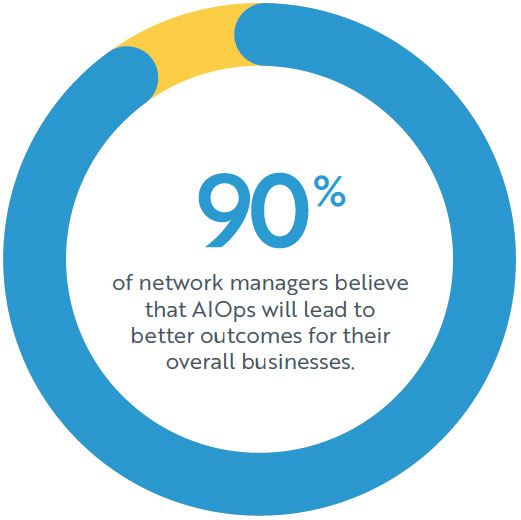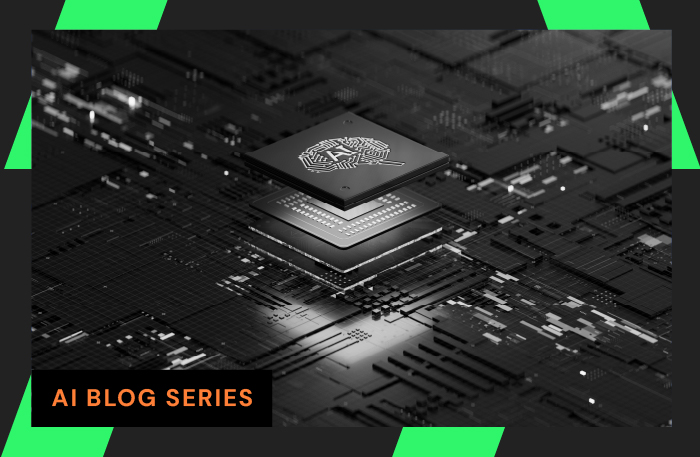Contents
Are you struggling with data overload?
The volume and diversity of data that NetOps must analyze has exponentially increased.
This white paper considers the factors behind this data explosion and suggests how to get an upper hand on it. Orchestrating your data stream with the right tools can transform chaos into actionable insights.
Our white paper drills down on:
- 6 benefits to using a Network Performance Management (NPM) solution
- Concerning statistics about tool fragmentation
- A look towards the future in network operations
Synchronize and simplify your data collection strategy with one solution today.
Network Managers Struggle with Data Overload
Network Data is Exploding
Network administrators and engineers live and die with data. Everything they do is grounded in network data, from capacity planning to monitoring and troubleshooting. Network operations success depends on tools that can collect and present this data effectively and efficiently.
Unfortunately, the amount of data that network management tools must collect is exploding, which is challenging the toolsets of many network infrastructure and operations teams.
Network Data is Exploding
- Traffic Volumes are Climbing
First, traffic volumes are growing rapidly. Users who once connected to the network via one device now use two or three devices. The Internet of Things (IoT) is driving endpoint connections into the billions. Work-from-home initiatives are driving expanded use of bandwidth-intensive video and collaboration applications. As traffic increases, more traffic data is generated. Network performance management tools must be ready to collect and analyze this exploding volume of traffic data.The number of places where tools must find and collect this data is also expanding. IoT devices are connecting from everywhere. Millions of people are working from home currently. Companies are increasingly multi-cloud, with workloads deployed with multiple providers and regions. Network tools that once collected data from six or ten on-premises locations must now collect data from hundreds or thousands of on-premises and off premises locations. - Network Data Diversity is Increasing
Network data is also becoming more diverse. Packets, flows, and device metrics remain essential, but other data sources are becoming more important. Overlay technologies like software-defined networking in data centers and software-defined WAN add new layers of infrastructure that generate their own operational data, often in proprietary formats. Cloud providers generate flow logs that can reveal public cloud network performance. Active, synthetic traffic is essential to understanding SaaS applications’ performance and end-user experience. - Cross-Domain Insights are Needed
Network operations teams need tools to collect and analyze these increasingly complex and voluminous oceans of network data. Moreover, these network management tools must correlate network insights with digital business operations. Network managers need contextualized insights that tell them how the network interacts with other parts of digital infrastructure. This means network management tools must consume data from other systems, like IT service management platforms.
After all, it’s not just about network intelligence. Network operations teams often find that complex IT service problems that force them to collaborate with teams from other IT domains are often caused by non-network issues, such as client-device failures, security system misconfigurations, security incidents, and server infrastructure trouble.1
Network operations success depends on tools that can collect and present data effectively and efficiently
Tool Fragmentation Obscures Big Picture
Given the volume and diversity of data that network managers need to analyze, managers need tools to pull this data together and present a big picture of the end-to-end network. Unfortunately, most network teams are not well positioned to do this. The typical network operations team uses four to 10 tools to monitor and troubleshoot their networks. This means they are using multiple tools with overlapping insights and potentially conflicting data stores. It also means they have a fragmented view of the network. Twenty-one percent of network managers say tool fragmentation is one of the biggest challenges with network operations. Another 19% say their biggest challenge is a lack of end-to-end network visibility.
In these fragmented toolsets, individual tools often struggle to provide valuable insights. For instance, network monitoring tools receive so many anomalous metrics and events that they drown their users in alarms. The average network manager reports that 43% of alerts generated by network monitoring tools are not actionable. In other words, the data that triggers an alert is not indicative of an actual problem. Unfortunately, it can take time for administrators and engineers to sort through these false alarms.
Once network managers have triaged events, it’s time for them to dig into those events. Here, too, network management tools often struggle to present data in a way that helps engineers and administrators solve problems. Thirty-five percent of network managers say their tools are ineffective at supporting problem isolation and identification, and 36% say their tools are ineffective at supporting root-cause analysis workflows.
The upshot of these issues is a network operations team that is reactive, constantly putting out fires. In the average enterprise, end users report 33%
of all IT service trouble to the help desk before the network operations team is aware of the issue. In organizations that experience significant traffic growth (and thus more data overload), this percentage climbs to 41%.

1 Unless noted otherwise, data cited in this research was first published in 2020 by Enterprise Management Associates in its research report “Network Management Megatrends 2020.”
The Power of a Network Performance Management Platform
With vast volumes of diverse data sets to collect and analyze, network managers need to take a platform approach to network performance management. They should seek a network performance management solution that can collect, correlate, and analyze as much of the data generated by their infrastructure as possible.
Collect and Correlate Diverse Data
Today’s network operations teams use multiple tools that focus on one or two types of data. They do one kind of data analysis well but lack any sort of visibility into the other classes of data that network managers need to consider. Also, important insights often emerge from correlations between different classes of data, such as device metrics and flows. Thus, engineers often serve as middleware, swiveling between tools to find the patterns of correlation.
Discover Correlations Between Different Data Types
A single tool that collects and analyzes all data can report on correlations between data types intrinsically, shortening workflows and allowing engineers to derive insights from the patterns that the tool presents.
Improve Data Quality
This platform approach to network performance management will also improve data quality. By establishing a single data store for critical network data, network managers can eliminate the data conflicts that can exist between different tools that might collect data at different intervals and have varying levels of data
collection errors.
Scalable and Flexible Data Collection
A network performance management solution that is designed to collect large volumes of diverse network data can be future-proofed. A network management team can select a platform that has the capacity to collect large volumes of network data today and be ready to scale up as more data becomes available. As new types of data become important to network operations, such a platform can adapt. These platforms should be ready to adapt to new data as it becomes relevant to operations, such as active, synthetic traffic, cloud flow logs, and new software-defined technologies.
From Data Overload to Efficient Operations
It’s important to remember how valuable time is to your network engineers and administrators. Everyone is always trying to accomplish more with fewer resources. Networking experts need to spend less time pulling information together and more time analyzing information. When a network performance management platform can correlate large and diverse data sets, engineers and administrators can focus more of their time on interpretation of the data.
A network performance management tool can consolidate diverse data sets into reports and dashboards. When multiple classes of data are presented in a single graph, patterns and anomalies start to reveal themselves to the network operator. This eliminates a situation where an engineer is studying two or more reports side by side and trying to line up timestamps and patterns. Now, an engineer can home into the data that is relevant and indicative of an issue. More importantly, they can quickly eliminate data that isn’t relevant to a given event or workflow.
The benefits don’t stop there. Workflows become available from these consolidated views of data. Once an engineer has connected the dots between different data sets, he or she can quickly pivot from one data set to another for a deep-dive analysis. They can accelerate the transition from problem isolation to root cause analysis, for instance. Device metrics might point them to an event, but packet metadata associated with those device metrics can provide the answer to the problem.
Finally, network managers can streamline fulfillment of their obligations to people outside the network team. They can consolidate report generation so that the finished products they send to compliance, security, and upper management are easier to consume. One report can present all relevant data in context. Siloed reports and manual report building across multiple tools are no longer necessary.
AIOps Foundation
Artificial intelligence for IT operations (AIOps) is the next step in this platform approach to network data. More than 90% of network managers believe that applying AIOps technology to network management will lead to better outcomes for their overall businesses.2 AIOps involves the application of artificial intelligence and machine learning to IT management. In networking, AIOps can streamline and automate network operations.
A network performance management platform that collects and correlates large and diverse sets of network data can serve as an excellent data lake for AI and ML algorithms. AIOps algorithms require extensive training to be useful. When they consume a large volume and variety of data, they will be more valuable to network managers.

2. EMA, “Revolutionizing Network Management with AIOps,” April 2021.
Futureproof Network Operations Against Data Overload
Data overload is in every network operations team’s future. Network management tools will continue to collect, correlate, and analyze large volumes of diverse network and non-network data. A network performance management solution that can consolidate these vast data sets into a single data lake will enable network managers to navigate a future in which networks are evolving in the face of new technologies and evolving business conditions.
Network managers who adopt this approach to network management will be prepared for a move into the public cloud, a rapid shift to work-from-home, adoption of new technology like SD-WAN, and IoT initiatives. They’ll also be better prepared to collaborate with other teams like security. They’ll be able to keep other parts of IT, and the business, informed about what is happening with the network.
Download White Paper
Solve Data Overload with a Comprehensive NPM
About LiveAction®
LiveAction provides end-to-end visibility of network and application performance from a single pane of glass. We provide enterprises with confidence that the network is meeting business objectives, full network visibility for better decisions, and reduced cost to operate the network.




